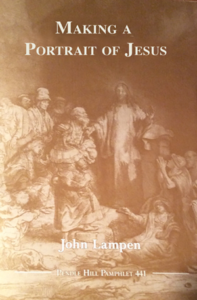Making a Portrait of Jesus
Reviewed by Brad Sheeks
February 1, 2017
 By John Lampen. Pendle Hill Pamphlets (number 441), 2016. 33 pages. $7/pamphlet.
By John Lampen. Pendle Hill Pamphlets (number 441), 2016. 33 pages. $7/pamphlet.
Many have found their way to the Religious Society of Friends via a journey that did not include learning about Jesus in Sunday school. Who was Jesus and what was it like in his time and place? Where can I find a short summary? John Lampen has offered just that in a new Pendle Hill pamphlet. Noting that his mother was an artist, Lampen uses the metaphor of painting a picture to give us a sense of the life and times of the historical Jesus.
What we are told of the life and death of Jesus is from the stories in the four gospels of the New Testament.
Lampen begins his portrait with a section on Jesus’s moral teaching. Jesus challenged the narrow morality of the traditional religion of his day; for example, the conventional belief that physical disabilities were caused by sin. He offended the Pharisees (strict traditional sect of Judaism) by healing the sick on the Sabbath day. He taught that love was more powerful than hate.
In the section on Jesus’s politics, Lampen notes that Jesus lived in a political landscape of occupation by the Roman Empire. His disciple Judas might have been aligned with a violent underground group. Simeon might have been aligned with a revolutionary group. The local religious leaders were either collaborators with the Roman authorities or were focused on a narrow moralism, and were therefore scandalized by Jesus’s respect for women and friendship with the poor.
Consequently, when Jesus rode a donkey into Jerusalem echoing a prophecy found in the Old Testament, he was showing them that, yes, he was a revolutionary, but in moral and ethical terms. While Jesus clearly was not a political threat to the Roman authorities, he was a serious challenge to the Sadducees (another strict traditional sect of Judaism that conflicted with the Pharisees) and the Pharisees. They accused Jesus of blasphemy and forced the hand of Pilate, the local Roman governor, who reluctantly agreed to execute Jesus.
The third and last brush stroke of this portrait is Jesus’s spiritual life. Jesus spoke of a loving and forgiving God whose main concern was for our well-being. He taught that our life task is to create a loving faith community. He called on his followers to love everyone—no exceptions.
Lampen, after completing his portrait of Jesus, writes a section on what happened after Jesus was executed and believed by his followers to have risen from the grave. His followers formed themselves into churches and recounted the various stories of the life of Jesus. These stories found their way into the written documents attributed to four of the disciples, Matthew, Mark, Luke, and John. The belief in Jesus as Savior was developed by early Christians as they thought about the meaning of Jesus’s death.
Early on, some believed that the new religion, Christianity, should be limited to those within the Jewish faith community. Others taught that all believers should be welcomed into the church. Christians disagreed about how divine Jesus was or was not. Others disagreed about whether Jesus’s teaching was a secret wisdom meant for a select few, or whether it was available to everyone.
By the end of the fourth century C.E., the church had agreed that the four gospels contained the official story of Jesus. Lampen notes slightly different perspectives in each of the gospels. Matthew seems to come out of a Jewish Christian tradition with increased emphasis on the idea that Jesus was the expected Messiah. Luke expresses a more universal tradition in which Christianity is for everyone, including the most rejected classes of society. Lampen writes that Mark was the earliest and least sophisticated of the gospels. These three gospels, Matthew, Mark, and Luke, share a very similar narrative of the life of Jesus. The gospel of John gives more attention to the church’s beliefs about Jesus as Savior.
It is beyond the scope of this pamphlet to explore what happened after Jesus died. With the Nicene Creed of 325 C.E., the church agreed that Jesus rose alive from the grave, is the risen savior, and continues as a spiritual presence in the church. That said, many are left with more questions than answers about what happened in the days and weeks after the death of Jesus.
Did Jesus actually say the things we read of in the gospels? Lampen leads us into the rarefied air of textual criticism. For example, the line from Matthew 5:44 in one ancient manuscript reads, “Love your enemies and pray for your persecutors.” Another manuscript adds the words, “bless those who curse you, do good to those who hate you.” Lampen suggests that these words were added to elaborate the more original, shorter version.
Lampen’s portrait of Jesus is of a person who has inspired countless people to live good lives and minister to those around them.



Comments on Friendsjournal.org may be used in the Forum of the print magazine and may be edited for length and clarity.